Each and every year, classic game titles celebrate their milestone anniversaries. There have always been a handful of major games which stood out among others, but last year was probably the best for the time being for Nintendo hardcore fans. In 2018, Super Mario Bros. 3 celebrated their 30th anniversary, Star Fox did their 25th, while it was the 20th time for The Legend of Zelda: Ocarina of Time, and so on.
However, it is more important to keep in mind more than just the famous, best-selling titles. Sometimes, a weird, unprecedented game, which the general gamer can easily forget, deserves recognition as well. Today we show you the short history of one such game, a shooter so unique that only some fans know about its last fall’s 25th anniversary - Yoshi’s Safari.
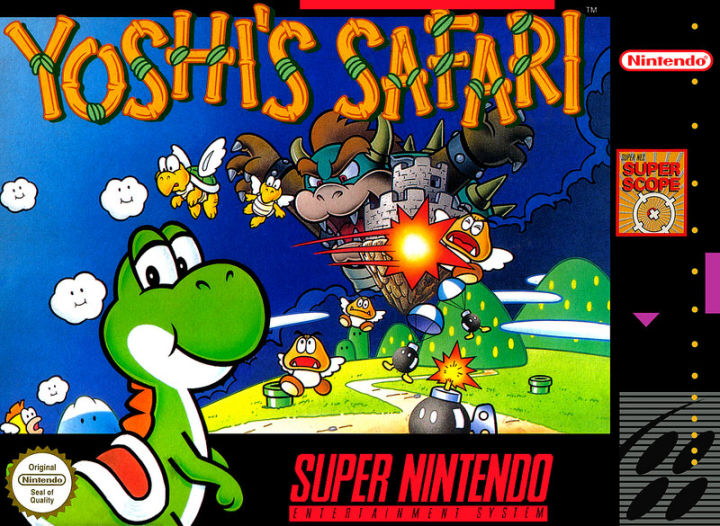 Yoshi’s Safari game cover
Yoshi’s Safari game cover
Shooting Down the Competitors
By the end of the year 1991, Nintendo has realized for quite some time that a competing product - the Sega Genesis - would prove to be quite an annoyance for their new gaming console Super NES. While the gaming manufacturer was determined about keeping their family-friendly impression, they also predicted that they had to somehow match the “cool factor” that Sega had incorporated in their advertising and games. Their brand new product needed an ace that can compete with its new adversary and Sony’s blue speedy hedgehog mascot Sonic.
Nintendo had enjoyed much success with the NES line of product over time, but the most iconic was probably the add-on NES Zapper, modeled after a light-busting gun. This success, coupled with the ever-pressing competition from Sega, was likely the main reason the Super Scope came to be - shoulder-mounter, wireless, heavily resembled a bazooka, and worked exclusively with the Super NES.
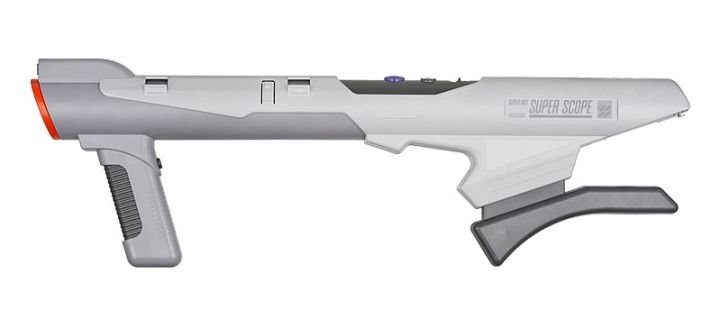 The Nintendo Super Scope
The Nintendo Super Scope
The Super Scope was released back in February 1992 to moderate interest from customers. It came packed with a cartridge consisting of six compatible mini-games and a wired transmitter. “You’re looking at the next breakthrough for the Super Nintendo,” declared a booming voice from the commercial introducing the device. However, with the price tag of $59.99 (which is about approximately $110 nowadays) and not many compatible games to support, the Super Scope was by no means the major successor “breakthrough” that Nintendo had originally intended it to be.
One year later, the war between the Sega Genesis and the Super Nintendo remained largely unchanged. The Super Scope’s disappointing sales number in the west ultimately led to a limited release in Japan, where this gun would be used mainly to promote the similarly disappointing movie, Super Mario Bros. Nintendo realized that their product’s popularity was threatened and hanging on a thread. Therefore, they ordered their R&D1 department to come up with a game compatible with the Super Scope featuring Mario, their star plumber. This was meant to be the Super Scope’s final chance to find its mainstream success.
The release of this new shooter featuring Mario in North American fell during a very controversial moment of gaming history. In September 1993, the arcade game Mortal Kombat was set to launch on both Sega and Nintendo's 16-bit gaming consoles. Fearing backlash from concerned parents, Nintendo demanded to have the trademark blood and gore striped from the game before release on their systems. This highly controversial move inadvertently stole the spotlight from their own upcoming game, Yoshi’s Safari. The age of the first person rail shooter genre would ultimately signal the end for Nintendo's Super Scope.
Ready, Take Aim, Fire ... Flower?
Yoshi’s Safari, known then in Japan as Yoshi’s Road Hunting, was certainly a flop. However, it was still an entry in the Mario saga that is worthy of revisiting. To begin with, although the title highly suggested that the main character was supposed to be the dinosaur Yoshi, you actually played as Mario riding on Yoshi in the first-person point of view. The fact that this game was, in fact, the first ever first-person Mario game is probably enough to make it worthy for a try, but it is actually Mario’s choice of weapon that truly cements the game weird legacy. Our favorite plumber, just like the players standing before their TV screen, held a gun. A toy-like looking gun with purple buttons, but still a gun after all.
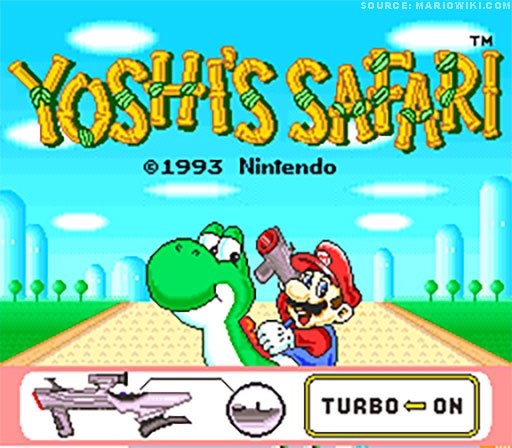 Yoshi’s Safari title screen
Yoshi’s Safari title screen
Yoshi’s Safari also marks the first time for many other things in the Mario universe. As a start, it takes place in a place called Jewelry Land, a location which bears many similarities to the Mushroom Kingdom in terms of inhabitants and terrain which has never appeared for the second time. Secondly, the game’s main story centers around Princess Peach, who calls upon Yoshi and Mario to save Jewelry Land’s rulers - Prince Pine and King Fret - who has recently been taken from the mischief Bowser of all people. While the king and prince can leave the audience wondering whoever they are, it is actually the title “Princess Peach” that is important. Yoshi’s Safari is the first time that this moniker was used in a Western Mario game. Every one of the previous games referred to the princess as Princess Toadstool. Afterward, it would be the game Super Mario 64 in 1996 that brought this title to more audience recognition.
About the gameplay, Yoshi’s Safari plays more like an arcade game. The twelve available stages were not by any means difficult or time-consuming, but the game gave players a leaderboard to keep track of their personal best scores, compare with others, which in turns promote multiple playthroughs. The continuously changing visuals in every stage were brought to players through the courtesy of the Super NES’s mode 7 capabilities, one technique which has been used in games such as Super Metroid and F-Zero to stretch or rotate the pixelated background.
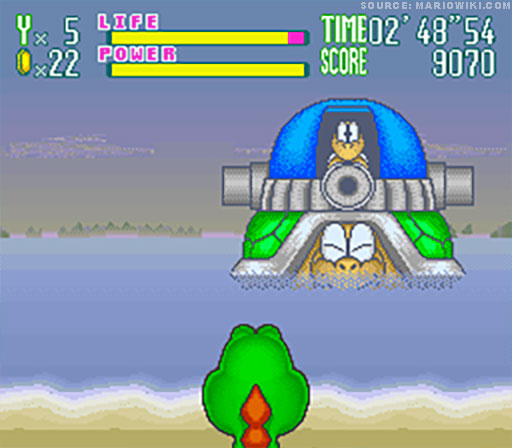 One of the game’s bosses
One of the game’s bosses
When it comes to the game’s villains, Yoshi’s Safari did not stray far from the normal cast of koopas, cheep-cheeps, and gumbas, but it was the extremely huge bosses that made the game stand out among the usual Mario experience. The Koopalings who have just been defeated in Super Mario World could be encountered at the end of the first stages, each in possession of their own huge personalized mech. Players would need to blast away laser cannons and rocket fists into these armored bosses’ weak spots to defeat them. Older Mario games always brought about a fantasy kind of feeling, but it was Yoshi’s Safari which brought the saga to a new realm of science fiction, guns blazing all the way through.
A mixture of all of those odd aspects, plus its unusual controller and upbeat soundtrack, really demonstrated how distinctive Yoshi’s Safari was at that time, and that fact remains till this day. This game also paved the way for some more experimental Mario games in recent years: For example, Mario + Rabbids Kingdom Battle would not exist without it. Yoshi’s Safari, although far from flawless, was still a pioneer ahead of the times in a lot of aspects.
While Nintendo has been through many years of Virtual Console support for home and handheld consoles, the game has never been re-released. Considering Yoshi’s Safari was such an entertaining and unique game even after twenty-five years, this is such a shame. The Super Scope console lives on through series of games such as WarioWare and SuperSmash Bros, but the very first of Yoshi and Mario’s gun blazing adventure might have sadly been their last.
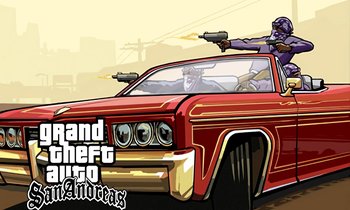
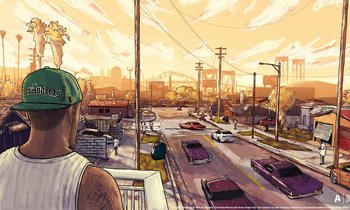








Comments